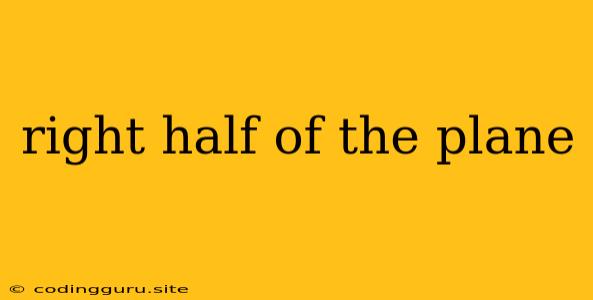Understanding the Right Half of the Plane
The right half of the plane is a fundamental concept in mathematics, specifically in coordinate geometry. It refers to a specific region of the Cartesian plane that is defined by a simple inequality. Let's explore what exactly this region is and how it's represented.
What is the Right Half of the Plane?
Imagine a standard Cartesian plane with the x-axis and y-axis. The right half of the plane encompasses all points where the x-coordinate is positive. This means that any point with a positive x-value will fall within this region, regardless of its y-value.
How is it Defined?
The right half of the plane is formally defined by the following inequality:
x > 0
This inequality states that all points where the x-coordinate is greater than zero belong to the right half of the plane.
Visual Representation
To visualize the right half of the plane, imagine drawing a vertical line that passes through the origin (0,0) and is parallel to the y-axis. This line divides the plane into two halves: the left half where x < 0, and the right half where x > 0.
Applications in Mathematics
The concept of the right half of the plane is used in various mathematical contexts:
- Graphing Inequalities: Inequalities involving x can be visualized by shading the corresponding region on the plane. For example, the inequality x > 3 represents the right half of the plane that lies to the right of the vertical line x = 3.
- Solving Systems of Inequalities: When solving a system of inequalities, the solution set is often represented by the intersection of the shaded regions corresponding to each inequality. This may involve the right half of the plane if one of the inequalities defines this region.
- Function Domains: The domain of a function is the set of all possible input values. In some cases, the domain might be restricted to the right half of the plane, for example, when dealing with functions like the square root function, which only accepts non-negative values.
Examples
Let's look at some examples:
- Point (2, 3): This point lies in the right half of the plane because its x-coordinate (2) is positive.
- Point (-1, 4): This point lies in the left half of the plane because its x-coordinate (-1) is negative.
- The Inequality x ≥ 5: This inequality represents the right half of the plane to the right of the vertical line x = 5, including the line itself.
Conclusion
Understanding the concept of the right half of the plane is essential in coordinate geometry and various other mathematical topics. It allows us to represent and analyze inequalities, graph functions, and solve systems of equations graphically. By understanding this simple concept, we can develop a deeper understanding of mathematical relationships and visualize their representation on the Cartesian plane.
